What Is Digital Merchandising & How Can It Boost Revenue?

What’s Inside
- What Is Digital Merchandising or Online Merchandising?
- Digital Merchandising Examples
- What is the Importance of Digital Merchandising?
- What Are the eCommerce Merchandising Strategies That Enhance Online Shopping Experience?
- Get Most Out of Your eCommerce Business with Strategic Merchandising
- What Are the eCommerce Merchandising Best Practices?
- What Are the Top Digital Merchandising Solutions?
- Convert Browsers into Buyers & See the Sales Go Up
- Conclusion
Key Takeaways
- Digital merchandising enhances the shopping experience by personalizing content based on user behavior analysis, increasing the relevance of products shown to each visitor.
- It is also known as eCommerce merchandising, is an effective way to increase conversions.
- Understanding your customers and their expectations is paramount, and data is the key to unlocking this insight.
- Experro is a digital experience platform that offers a robust eCommerce merchandising tool to enhance product discovery.
The way marketers present their products (digital merchandise) matters!
The eCommerce businesses may have an extensive product catalog on their website, they can be extremely captivating, too.
However, the key lies in showing the right product at the right time!
Whether it's about enhancing the in-store experience or digital, presentation is of utmost importance to grab the attention of shoppers. That is where digital merchandising comes into play.
Effective online merchandising strategy not only enhances user experience but can turn visitors into customers.
If you are into eCommerce business, you must not miss the tips and tricks to master digital merchandising.
So, in this blog, we will discuss the concept of digital merchandising.
We will deep dive into the proven strategies of digital merchandising to elevate eCommerce customer experience and increase sales!
Without further ado, let’s understand the meaning of digital merchandising.
What Is Digital Merchandising or Online Merchandising?
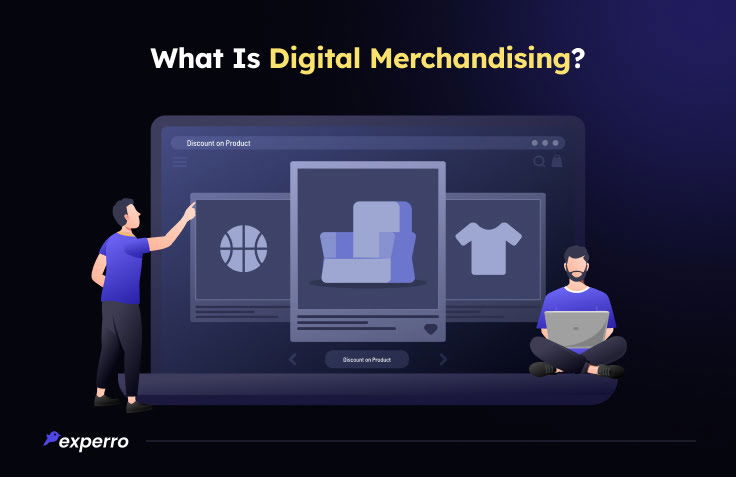
Digital merchandising definition (Online merchandising definition) - Digital merchandising refers to the strategic approach of promoting products on eCommerce websites in a way that influences users to make a purchase.
eCommerce merchandising definition is also the same. This is because it is popular with many terms, such as online merchandising, digital visual merchandising, and eCommerce merchandising.
Digital merchandising includes the following key elements:
- Product placement
- Visual presentation
- Pricing strategies
- Personalization
- Promotional activities
Digital Merchandising Examples
If you are wondering what is an example of product merchandising, here you go:
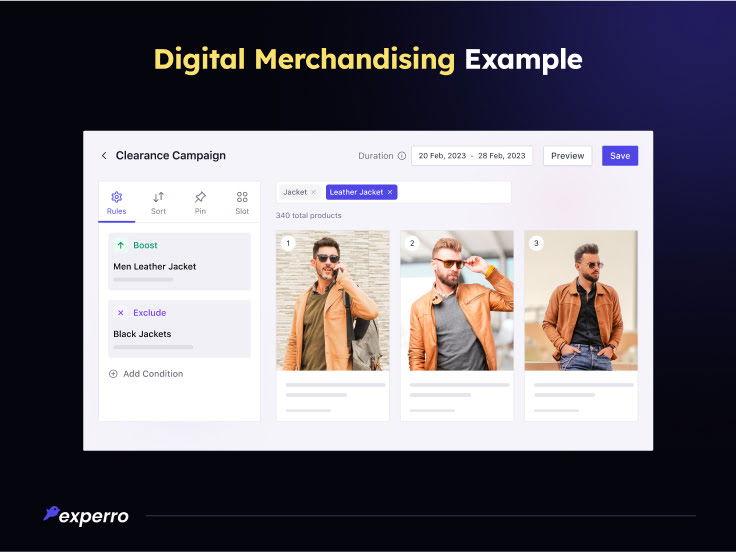
Now that we have explored the digital merchandising meaning, let's understand it to a better depth by checking out the digital merchandising examples.
In the evolving landscape of digital commerce, innovative digital merchandise examples are setting new standards for how consumers interact with products and brands online.
Suppose an eCommerce merchandiser has got a clearance campaign around the corner. To boost particular clearance products, they can prominently showcase them on the website.
They can place specific products on high-traffic pages where users frequently browse.
The above image shows that the men's leather jacket category is boosted to optimize the clearance campaign.
The black jacket category is not in the market's priority to increase sales at the moment, so they have excluded that item. This is how they can prioritize the item they want to boost.
By implementing this approach, digital merchandisers can effectively boost visibility and interest in the clearance items. This significantly increases the chances of purchase. That is one of the ways you can leverage the digital merchandising hub features.
What is the Importance of Digital Merchandising?
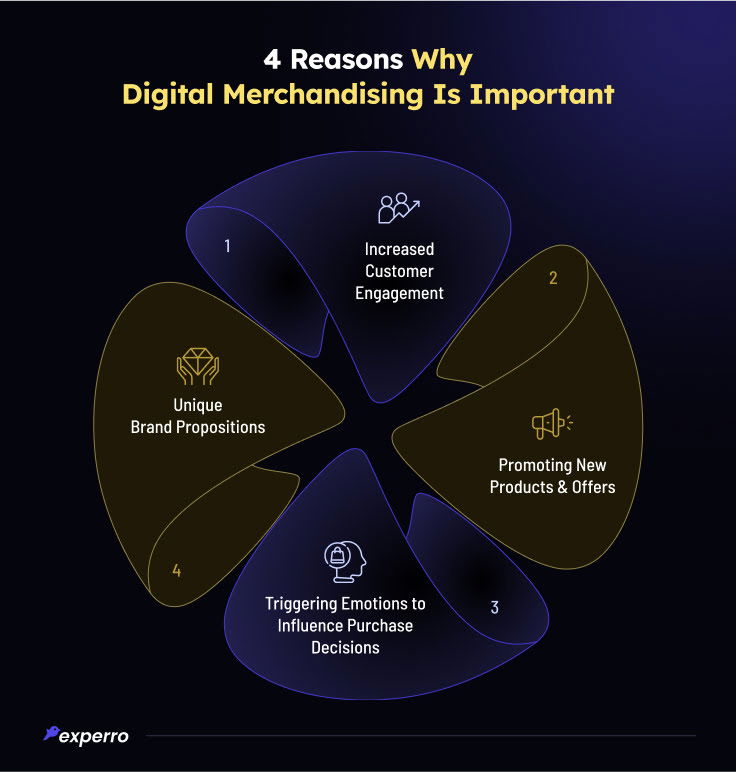
Digital merchandising is important for boosting revenue and conversions. The following points highlight the importance:
1. Increased Customer Engagement
When users come across the digital merchandise they are interested in, they are likely to click and explore those products.
Through visually appealing displays, personalized recommendations, and interactive content, businesses can captivate the attention of their online audience.
Tailor product suggestions based on browsing history or preferences streamline this shopping experience and create an enjoyable experience for users.
This not only boosts the customer’s satisfaction but also fosters a sense of connection, making customers more likely to explore a broader range of products and return for further purchases.
2. Promoting New Products & Offers
Digital merchandising strategies are a great way to promote new products and offers.
For that, marketers need to identify how to strategically place particular products so that they grab users' attention.
These promotions can include time-sensitive information such as limited discounts and exclusive deals, create a sense of urgency, and motivate customers to explore and make purchases promptly.
For instance, they can place their best-selling products on the landing page, promote special edition offers, or festive sales.
3. Triggering Emotions to Influence Purchase Decisions
Did you know that 71% of customers recommend a brand based on their emotional connection to it?
Digital merchandising taps into the emotional aspect of consumer behavior by going beyond mere product displays.
Anyone can display their products on the landing page or product catalog, but how smartly and strategically you place it defines the outcome of marketing strategies.
It not only helps to showcase products but also creates a dynamic and engaging customer experience that truly resonates with the target audience.
For instance, instead of merely presenting products in a cluttered list, digital merchandising strategically positions trending items based on other customers' purchase history.
This approach enables users to discover what's popular among like-minded shoppers, creating a more personalized and engaging shopping experience.
4. Unique Brand Propositions
Establishing a unique brand is paramount in the competitive digital landscape. There are millions of online platforms available for customers. Hence, you need to make customers stop at your online store. For that to happen, you got to be the best e-merchandising platform.
This is possible with effective brand management and unique brand propositions about your online business so that customers find it attractive and engaging.
Some tips for effective brand proposition are as follows:
- Consistent brand messaging
- Clear and compelling CTAs
- High-quality product images
- User-friendly website design
- Trust-building elements (e.g., reviews, case studies)
What Are the eCommerce Merchandising Strategies That Enhance Online Shopping Experience?
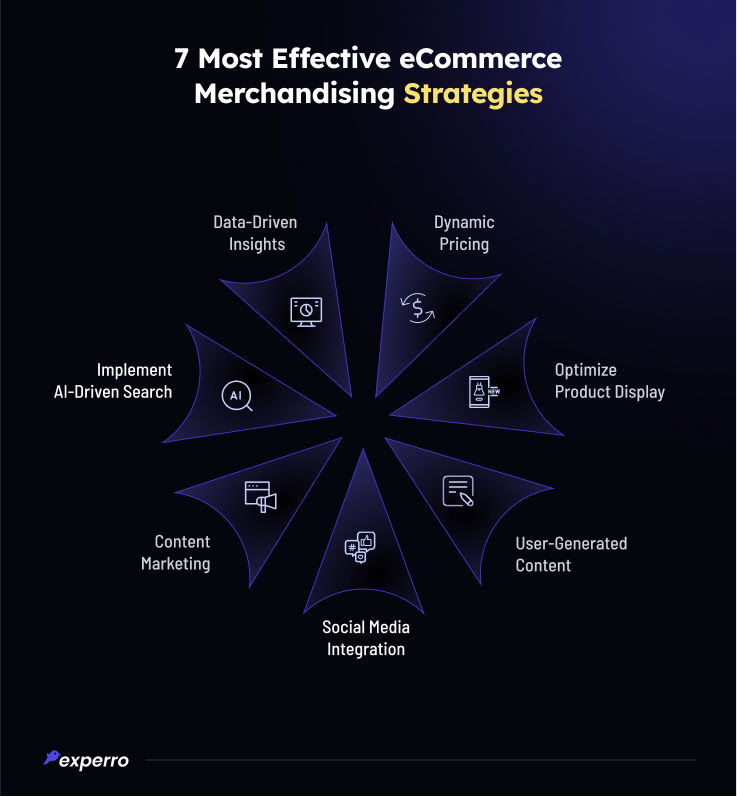
The following points highlight effective online merchandising strategies:
1. Data-Driven Insights
The core of a successful digital merchandising strategy lies in the effective utilization of customer data.
Data-driven insights provide you with rich insights into user behavior and preferences.
This will help marketers to tailor merchandising strategies for the target market.
By utilizing digital experience analytics, businesses can understand customer preferences and provide the most relevant products.
2. Dynamic Pricing
There are no bad products, only bad prices.
This quote has become a widely used concept in marketing and pricing strategy.
It emphasizes how strategic pricing contributes to a product's success rather than just its inherent quality or features.
Implement dynamic pricing algorithms that adjust prices in real-time based on factors like demand, inventory levels, or customer behavior.
This can create a sense of urgency and encourage immediate purchases when customers see prices fluctuating.
3. Optimize Product Display
Optimizing product display involves strategic presentation of products to capture customer attention and facilitate easy navigation.
This can include organizing products based on popular categories, utilizing high-quality images, and providing detailed and SEO-friendly product descriptions.
Additionally, implementing techniques like highlighting bestsellers in featured products section and creating visually appealing products can influence customer purchasing decisions.
The goal should be to create an intuitive and seamless product experience that guides customers through their shopping journey and encourages them to explore more products.
4. User-Generated Content
An interesting statistic says that 79% of individuals believe user-generated content influences their purchase decisions.
Incorporating usage and rated content into the marketing strategy adds authenticity and credibility to the eCommerce business.
It involves encouraging customers to share reviews, testimonials, and images of their purchased products to create a community-driven atmosphere.
This not only enhances the user experience but also fosters real-world insights and contributes to a sense of community around the brand.
5. Social Media Integration
Integrating social media into eCommerce personalized merchandising is the most powerful strategy today.
Social media platforms serve as a dynamic channel for showcasing products and running promotions campaigns and marketing strategies.
Moreover, today's generation, like Gen Z and Millennials, are more active on social media than other digital channels.
So, utilizing these social media channels to promote products and captivate the more extensive user base is the most thoughtful strategy.
6. Content Marketing
Content marketing is crucial in driving organic traffic and establishing the brand.
Creating a high-quality and informative digital content strategy engages users, attracts potential customers, and adds value to their online experience.
This content can include blog posts, how-to guide videos, and more.
It is essential to align the content with the interests and needs of the target audience, providing relevant information that enhances the overall brand perception and encourages repeat visitors.
7. Implement AI-Driven Search
AI-driven searches enhanced the efficiency and accuracy of products, such as discovery on eCommerce platforms.
Imagine a user trying to search for a particular product but not getting accurate results and ends up leaving a website.
How frustrating can that be?
However, AI-powered search by Experro ensures that users get accurate results on their search queries. It understands natural language processing and uses autocorrect to provide accurate results as quickly as possible.
This approach makes users strict on the website, reduces bounce rates, and also enhances their shopping experience.
What Are the eCommerce Merchandising Best Practices?
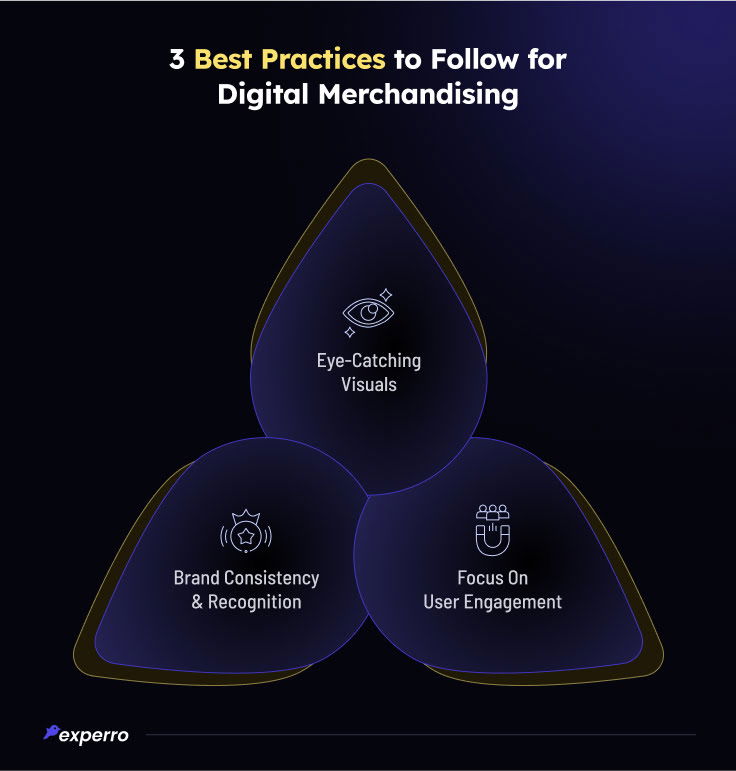
Follow these best practices for a successful digital merchandising strategy:
1. Eye-Catching Visuals
Effective digital merchandising starts with compelling visuals that can capture users' attention immediately.
These visuals can be high-quality images, engaging graphics videos, and visually appealing content crucial in creating a positive first experience.
Additionally, strong visuals can evoke emotions for starting a connection between the consumer and the product.
2. Brand Consistency & Recognition
Consistent visual elements such as color fonts and images contribute to brand recognition.
Establish a cohesive visual identity across all the digital channels such as websites, social media, and mobile apps, build trust, and reinforce brand loyalty.
3. Focus On User Engagement
Enhancing user engagement through digital merchandising involves a strategic blend of visually appealing websites, personalized experiences, and seamless navigation.
It's imperative to prioritize mobile-first eCommerce experiences to cater to the diverse preferences of your customers.
Moreover, consider offering tailored product recommendations informed by customers' past purchase history and browsing preferences.
By incorporating these elements, you can create a dynamic and engaging online shopping environment that resonates with your audience and fosters lasting customer relationships.
What Are the Top Digital Merchandising Solutions?
Following are the popular digital merchandising tools and solutions:
1. Experro
Experro is a cutting-edge digital experience platform that also offers eCommerce merchandising. This feature enables businesses to present the right product at the right time in front of the right people.
You don't need 10 different eCommerce merchandising tools. In fact, you can do 10 different things using the same Experro platform.
Want to boost certain products for campaigns?
Want to A/B test to identify the best-performing products?
Want to personalize landing pages?
Don't worry; Experro has got you covered!
Experro helps to identify the user's preferences and deliver content tailored to their needs. We have a proven record of merchants worldwide trusting Experro for their eCommerce business.
You can use the product taxonomy tactics for your eCommerce platform. It not only helps with lucrative business strategies but also builds long-lasting customer relationships. And that's what matters in the fast-paced digital landscape.
2. Yieldify
Yieldify is a personalization platform. It offers various (paid) online merchandising tools for creating personalized campaigns, including overlays, dynamic social proofs, and existing pop-ups.
It aims to increase conversion and customer retention by providing a range of targeted and personalized interactions.
3. Bloomreach
Bloomreach is an AI-powered digital experience platform that offers personalized search and digital merchandising solution to enhance product discovery and drive conversions.
4. Salsify
Salsify is a product information management (PIM) platform that helps businesses manage, enrich, and syndicate product content across multiple channels, ensuring consistency and accuracy in product merchandising.
Conclusion
Digital merchandising plays a crucial role in creating a visually appealing, user-friendly, and personalized online shopping experience that drives sales.
Most importantly it shows the right product at the right time to increase the likelihood of purchase. Experro is the best e-merchandising software (platform) for your eCommerce needs.
If you want to boost eCommerce sales with effective merchandising, book a call with the experts at Experro!
FAQs


Priya Zala
27 June 2024Through her writing, she has a lovely way of capturing users' pain points and delivering solution-oriented content. Her writing is sure to captivate readers and leave them with a lasting impression. When not crafting content, Priya enjoys getting lost in a good work of fiction, which soothes her soul.